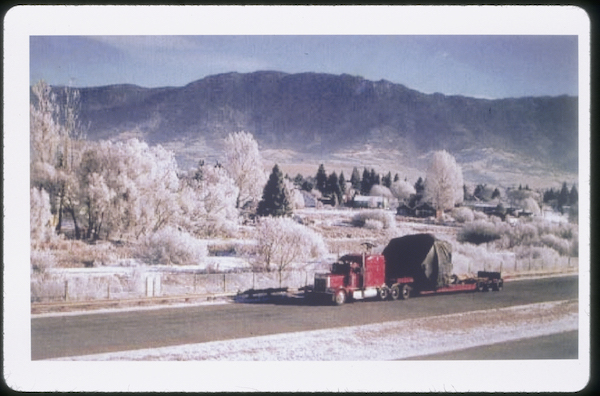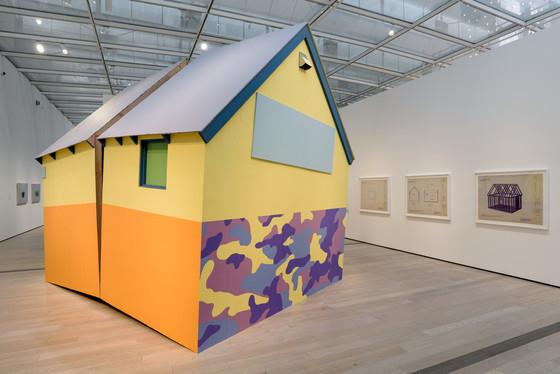On August 1, the eight-episode TV special Manhunt: Unabomber will premiere on the Discovery Channel, providing an in-depth look at how the FBI tracked down “domestic terrorist” Theodore (Ted) Kaczynski. In 1996, after an 18-year search, the former math prodigy and university professor was arrested at his small cabin in the Montana wilderness.
This renewed interest in the Unabomber comes at a time of heightened rhetoric about terrorism from abroad, but also amid profound threats to constitutional rights at home. For L.A. artist Daniel Joseph Martinez, the best place to explore this renewed interest and its implications for our nation is none other than Kaczynski’s cabin.
In 2004, in the aftermath of September 11 and the start of the Iraq War, Martinez set out to create a to-scale replica of Kaczynski’s cabin. At the time, Martinez recalled the spectacle of the cross-country transportation of Kaczynski’s cabin so that it could serve as forensic evidence of terrorism. But he was also intrigued by the fact that Kaczynski had been inspired by the Massachusetts cabin built by naturalist, philosopher, and poet Henry David Thoreau and where he wrote Walden. In modeling his home after Thoreau’s own design, Kaczynski moved beyond a simple survivalist tactic. Instead, he placed his retreat from what he later called “industrial society” within a longer tradition of American political and social thought. It is here, in this cabin built in 1971, where Kaczynski turned to terrorism as a response to destruction of the natural environment around him.
In late spring 2017, Martinez created a new iteration of this cabin for the exhibition Home—So Different, So Appealing, on view through October 15. When Martinez created the first one in 2004, Kaczynski’s cabin was presumed destroyed, so bringing forth a recreation provided a reminder of domestic terrorism during a time of growing Islamophobia and anti-immigrant politics. Ironically, Kaczynski’s cabin was being stored in an undisclosed location, and, in 2008, it became part of the permanent collection at the Newseum in Washington, D.C., a public charity whose mission is “to champion the five freedoms of the First Amendment.”
This history—and the fact that the actual cabin is now being exhibited concurrently with an artist’s recreation of it—adds another layer to the work’s meaning. “This cabin is an embodiment of the ethos of [President] Trump,” Martinez stated in a recent LACMA Facebook Live interview. “Is our only object to accumulate wealth? Is our only object to become famous? Is our only object to degrade other human beings so far that we become inhuman as species . . . I mean, what has happened to this country?”

One possible answer can be seen in the formal elements of the work itself. The House That America Built (El hogar que Estados Unidos construyó), 2004/2017, is not just a literal recreation: it’s an art historical argument about American identity at a turning point in the nation’s history. The cabin is brightly painted with colors from the spring 2017 palette of Martha Stewart Signature Paint™. In 2004, as Martinez first recreated the cabin, Martha Stewart was convicted of insider trading. Drawing on Kaczynski and Stewart’s simultaneous incarceration in federal prison and their similar family backgrounds—both are second-generation, Ivy-league educated, Polish Americans—Martinez links a domestic terrorist with a domestic hypercapitalist.
“It’s an attempt to interrogate two polar opposite representations of whom we have become in the United States,” Martinez said.
The multi-colored work is also layered with art historical references. Viewers will notice a split in the structure invoking Gordon Matta-Clark’s film Splitting (1974, also in the exhibition), in which the artist saws a house in half; and a large swath of camouflage, a form of abstractionism that fascinated Andy Warhol.
So, while Manhunt: Unabomber will offer a docudrama approach to domestic terrorism, Martinez’s The House That America Built casts a wider net, looking beyond the particulars of the Unabomber case toward the larger questions about the house that we—as Americans—are building.
View this and other works by Martinez in Home—So Different, So Appealing at LACMA through October 15, 2017. Home—So Different, So Appealing is part of Pacific Standard Time: LA/LA, a far-reaching and ambitious exploration of Latin American and Latino art in dialogue with Los Angeles.



